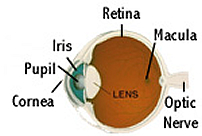Uveitis
 Uveitis is an often chronic condition that involves inflammation of the uvea. The uvea is the middle layer of the eye, which contains the iris, ciliary body and choroid and is located between the retina and sclera (white of the eye). This condition is most common in patients between the ages of 20 and 50 years old, and may be caused by a viral, fungal or bacterial infection. In many cases of uveitis, the cause is unknown.
Uveitis is an often chronic condition that involves inflammation of the uvea. The uvea is the middle layer of the eye, which contains the iris, ciliary body and choroid and is located between the retina and sclera (white of the eye). This condition is most common in patients between the ages of 20 and 50 years old, and may be caused by a viral, fungal or bacterial infection. In many cases of uveitis, the cause is unknown.
There are three different types of uveitis, classified by the area of the uvea that is affects:
- Anterior uveitis – inflammation of just the iris or the iris and ciliary body
- Intermediate uveitis – inflammation of the ciliary body
- Posterior uveitis – inflammation of the choroid
Patients with anterior uveitis, the most common type, are often only affected in one eye, and may experience mild to strong pain, redness, light sensitivity and blurred vision. Intermediate and posterior uveitis are usually painless and may cause blurred vision and floaters in both eyes.
For any questions or to get more information about uveitis, please contact us at Prism Eye Institute today.
